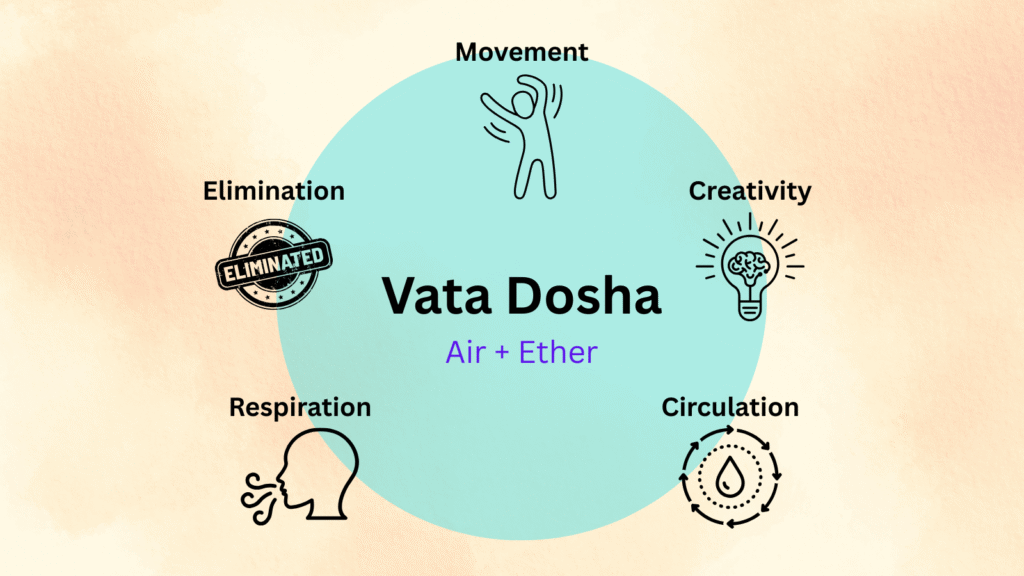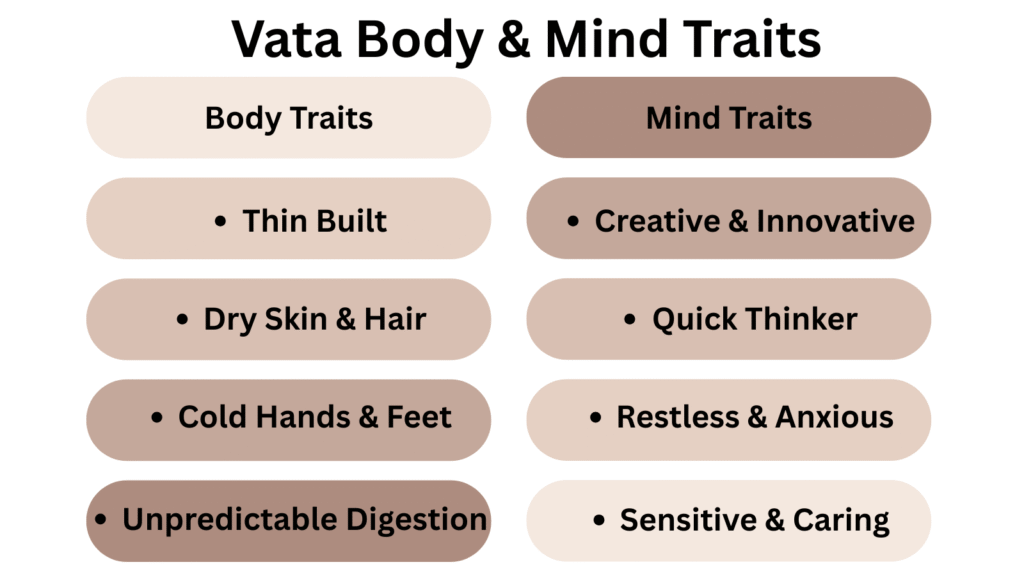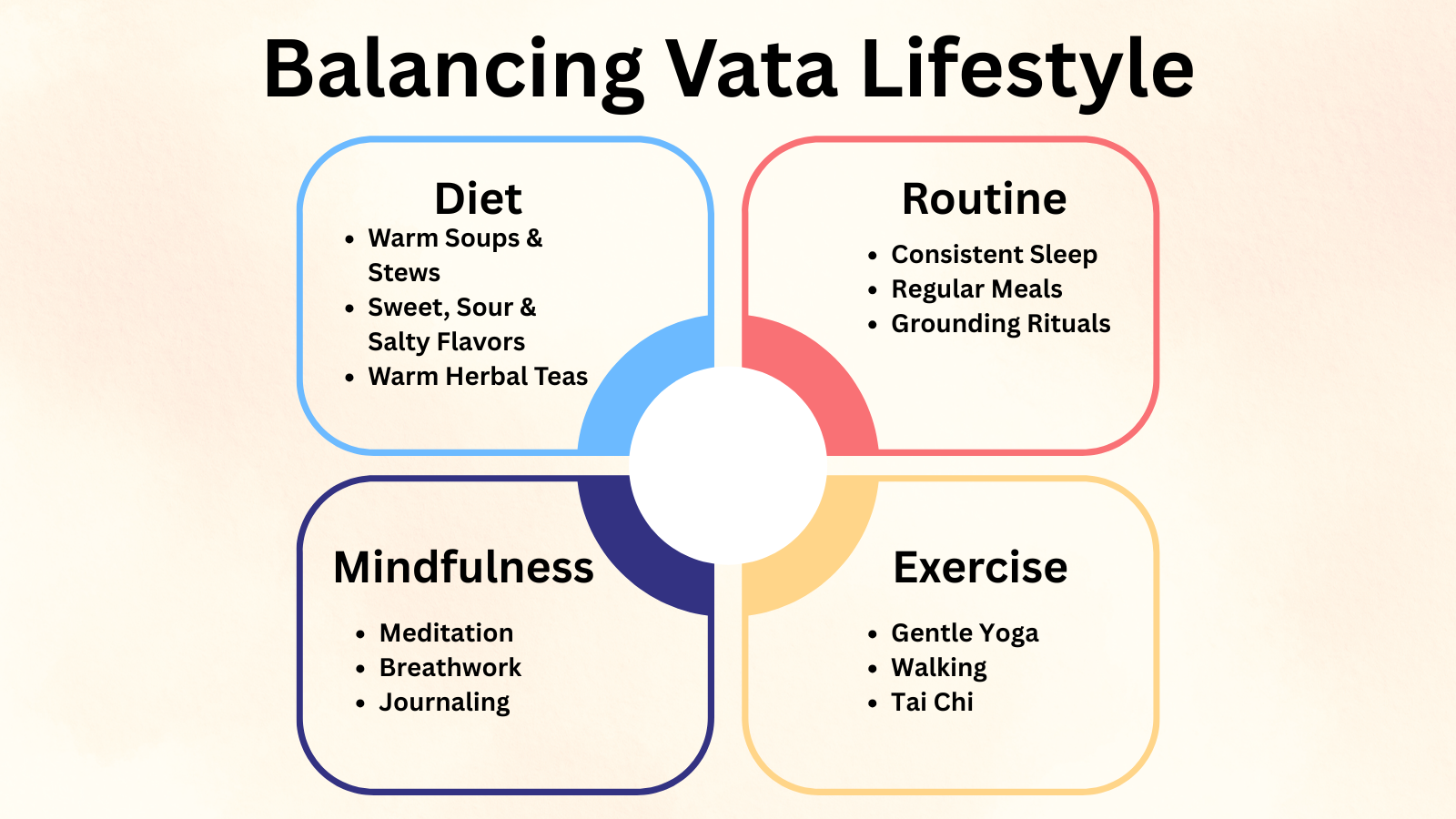
Do you feel like things are out of order or make you uneasy? You might have trouble focusing or have skin that is dry and rough. If you can relate to these feelings, your Vata dosha may be out of balance.
Learning more about Vata can change your life for the better in both your mental and physical well-being.
Ayurveda is an old Indian system of holistic healing that teaches us about the three doshas: Vata, Pitta, and Kapha. Each dosha has its own physical and emotional characteristics that affect how we live our lives every day.
Diving into the world of Vata can help you find ways to improve your health.
This guide will walk you through everything you need to know about mastering your Vata dosha—from its defining traits to practical tips for achieving balance in every aspect of life.
So let’s embark on this journey together!
An Overview to understand Vata Dosha

Ayurveda says that vata dosha is one of the three main energies. It stands for the elements of air and ether. It represents movement and creativity, which make it both necessary for growth and change.
This dosha governs bodily functions such as circulation, respiration, and elimination.
When Vata is balanced, you feel energetic and inspired. However, an excess can lead to feelings of anxiety or restlessness.
People with a strong Vata prakriti usually have thin bodies and quick minds.
They are usually flexible, but they might have trouble with routine because they like to do things on the spur of the moment.
Getting to know your unique relationship with Vata can help you learn more about your health patterns.
You’ll be better able to find peace within yourself if you know how it affects both your body and mind and cultivate harmony within yourself.
You can also learn more about Tridosha here.
The Definition of Dosha and Its Types
In Ayurveda, dosha refers to the three main energies that control our physical and mental traits.
Each person has a different mix of these doshas, which affects their health, personality, and general well-being.
There are three primary doshas: Vata, Pitta, and Kapha. Vata is linked to creativity and movement. Pitta is all about transformation and intensity. Kapha stands for stability and structure.
Knowing your doshic balance can help you understand your strengths and weaknesses.
This knowledge can help you make choices that make you feel more at peace with yourself.
Each type has its own traits that affect how we interact with the world around us.
Recognizing these differences helps people become more self-aware and encourages overall health by encouraging people to change their lifestyles.
Characteristics of Vata Prakriti
Vata Prakriti is often described as light, dry, and cool.
People with a lot of Vata dosha tend to be thin and very flexible. They have a lot of creative energy and are always coming up with new ideas.
People with Vata characteristics can think quickly, but their moods can change quickly too.
They are great at solving problems because their minds race from one idea to the next, but they can also get anxious.
On the physical front, they might have dry skin and hair that doesn’t shine. Digestion can be unpredictable, so it’s important to keep their eating habits stable for their health.
Vatas may also have trouble sleeping or find it hard to relax at night because their minds are always racing.
Embracing routines can help them find balance in their lives, and grounding practices can help them feel more stable and less restless.
The Vata Dosha Body Type: Traits and Behaviors

People with a Vata body type often have a unique mix of traits and behaviors.
They are usually thin and may have dry skin, as well as hands and feet that are cold. This physical form shows their elemental composition: air and space.
Vatas are known for being able to move from one idea to the next quickly.
They are natural innovators in many fields because their creativity knows no bounds. But this fast way of thinking can sometimes make one feel restless or anxious.
People with Vata types are sensitive and caring when it comes to their feelings. They have deep connections with other people, but because they are always changing, they may have trouble being consistent.
This fluidity is charming, but it can also make it hard to stick to routines or keep promises.
These traits make Vata people both interesting and complicated. This shows how important it is to find a balance between nurturing their strengths and dealing with their weaknesses.
The Vata Personality: Strengths and Weaknesses
People with a Vata personality are often creative and excited.
These people are usually creative thinkers who come up with new ideas. They are natural visionaries because they can see the big picture.
But this spontaneity can also cause things to be inconsistent.
People with vata types may have trouble following through on projects or promises. They might go from one idea to another without really seeing how good they could be.
They are friendly and outgoing in social situations, but they can get overwhelmed in big groups. When they’re not grounded, this sensitivity can make them anxious or restless.
On the plus side, their ability to adapt makes it easy for them to deal with change.
But if you don’t keep an eye on it, this flexibility can turn into not being able to make up your mind. It is important to find a balance between these strengths and weaknesses in order to promote health in people with a Vata dosha.
Recognizing Vata Imbalance: Signs to Watch For
It’s important to know your vata imbalance in order to stay healthy.
If your mood or energy levels change suddenly, it could be a sign that your Vata dosha is out of balance.
Dry skin or hair and stomach problems like bloating are two examples of physical symptoms.
If you feel anxious or restless, pay attention to these common signs that you have too much Vata.
You might also have trouble focusing or have trouble sleeping. These signs often mean that someone is overstimulated, which can make imbalances that are already there worse.
When Vata is out of balance, it can make you more sensitive and unpredictable on an emotional level.
If you notice these signs early, you can take steps to bring peace back into your life.
Common Vata Dosha Symptoms
There are many signs of a vata dosha imbalance.
People with a lot of Vata often feel dry both physically and emotionally. The skin may become rough, and the hair may lose its shine.
Problems with digestion are also common.
People may have bowel movements that aren’t regular or feel bloated a lot. This is because Vata energy changes all the time, which affects digestion.
Another clear sign is trouble sleeping. If your mind is racing and you can’t settle down at night, you might feel tired during the day.
These physical symptoms can also make you feel anxious and nervous. People with Vata types tend to think quickly, which can make them feel bad.
Recognizing these signs early on helps you take steps to get back to balance and health, which makes it easier to deal with life’s problems.
To know more about Vata Dosha, its symptoms, and its treatment, you can read more here.
Effective Strategies for Vata Balance
To achieve Vata balance, you need to stick to a routine.
This active dosha feels better when things are organized and consistent. Make sure you eat and sleep at the same times every day.
Nourishing goods play a crucial role as well. Choose meals that are warm, moist, and rich in healthy fats. Think of thick soups and stews that help ground the Vata energy.
Exercise should be gentle but still fulfilling. Yoga and tai chi are two activities that can help you calm your mind and body without overstimulating them.
Another important thing is to stay hydrated. Instead of cold drinks, drink warm herbal teas.
This easy change helps your digestive fire and calms your body at the same time.
Adding calming activities like deep breathing or writing in a journal can also help you think more clearly and feel more stable. These strategies help you stay calm in the middle of the chaos of daily life.
Diet and Lifestyle Tips for Balancing Vata

To balance Vata dosha, eat foods that are warm and nourishing.
Add cooked foods like soups and stews to your diet. These foods are easier on the stomach and help calm it down.
Choose flavors that are sweet, sour, and salty. Avocados, bananas, and warm grains are some foods that can give you grounding energy.
Instead of cold drinks, drink warm herbal teas to stay hydrated. This one simple change can help with digestion and relax the nervous system.
For Vata balance, it’s important to have regular routines. To make your life more stable, try to get up and go to bed at the same time every day.
Gentle exercise like yoga or walking keeps your body grounded without overstimulating it.
Pay attention to what your body needs. During times of high Vata, slow movements are often better than hard workouts.
Doing creative things also helps keep your Vata personality in balance by giving you a way to express yourself and keeping you from feeling restless.
The Role of Mindfulness and Meditation in Vata Wellness
Mindfulness and meditation are great ways to help people balance their Vata dosha.
Because Vata is light and moves around a lot, it can make people feel anxious or restless. Mindfulness practices help these changing energies stay stable.
Meditation gives the mind a safe place to go. People can calm their racing thoughts by focusing on their breath, which helps them stay in the present moment.
This feeling of calm is important for keeping Vata body types in balance.
Adding mindful activities to your daily routine can help keep this balance.
Taking nature walks or enjoying meals can help you become more aware of your surroundings and connect with them. These activities not only calm the nervous system, but they also make you feel better overall.
By making a commitment to do mindfulness exercises on a regular basis, you create a safe space that promotes stability and calm, which are two things that are very important for people with a Vata prakriti to thrive.
Conclusion: Embracing Your Vata Dosha for Optimal Health
Accepting your Vata dosha can make a big difference in how healthy you feel overall.
You can make your life better for your health by learning about the unique traits of Vata prakriti. You can bring balance back into your life by recognizing the signs of vata imbalance and using effective methods like mindful practices and changes to your diet.
While grounding yourself, make sure to eat foods that are good for you.
Self-awareness is very important; knowing when you’re leaning too much toward vata traits can help you take steps to bring harmony into your life.
Every person’s journey is a chance to learn and grow.
It might not always be easy to learn how to deal with your Vata body type, but if you are patient and work hard, it will be a rewarding experience.
By accepting the good things about your Vata personality and working on the bad things, you can build strength in your mind, body, and spirit. This will make your life more vibrant and full of joy and energy.
Take this journey with all your heart, because each step gets you closer to finding lasting health that is right for you.
If you’re curious about the root meaning of Vata, see our article on Vata Meaning in English.

